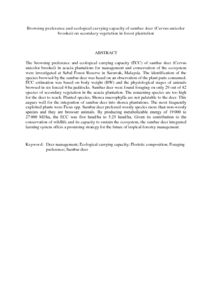Citation
Ismail, Dahlan and Jiwan, Dawend
(2014)
Browsing preference and ecological carrying capacity of sambar deer (Cervus unicolor brookei) on secondary vegetation in forest plantation.
Animal Science Journal, 86 (2).
pp. 225-237.
ISSN 1740-0929
Abstract
The browsing preference and ecological carrying capacity (ECC) of sambar deer (Cervus unicolor brookei) in acacia plantations for management and conservation of the ecosystem were investigated at Sabal Forest Reserve in Sarawak, Malaysia. The identification of the species browsed by the sambar deer was based on an observation of the plant parts consumed. ECC estimation was based on body weight (BW) and the physiological stages of animals browsed in six fenced 4-ha paddocks. Sambar deer were found foraging on only 29 out of 42 species of secondary vegetation in the acacia plantation. The remaining species are too high for the deer to reach. Planted species, Shorea macrophylla are not palatable to the deer. This augurs well for the integration of sambar deer into shorea plantations. The most frequently exploited plants were Ficus spp. Sambar deer preferred woody species more than non-woody species and they are browser animals. By producing metabolizable energy of 19 000 to 27 000 MJ/ha, the ECC was five head/ha to 5.25 head/ha. Given its contribution to the conservation of wildlife and its capacity to sustain the ecosystem, the sambar deer integrated farming system offers a promising strategy for the future of tropical forestry management.
Download File
![[img]](http://psasir.upm.edu.my/36687/1.hassmallThumbnailVersion/Browsing%20preference%20and%20ecological%20carrying%20capacity%20of%20sambar%20deer.pdf)  Preview |
|
PDF (Abstract)
Browsing preference and ecological carrying capacity of sambar deer.pdf
Download (185kB)
| Preview
|
|
Additional Metadata
Actions (login required)
 |
View Item |

